Menu
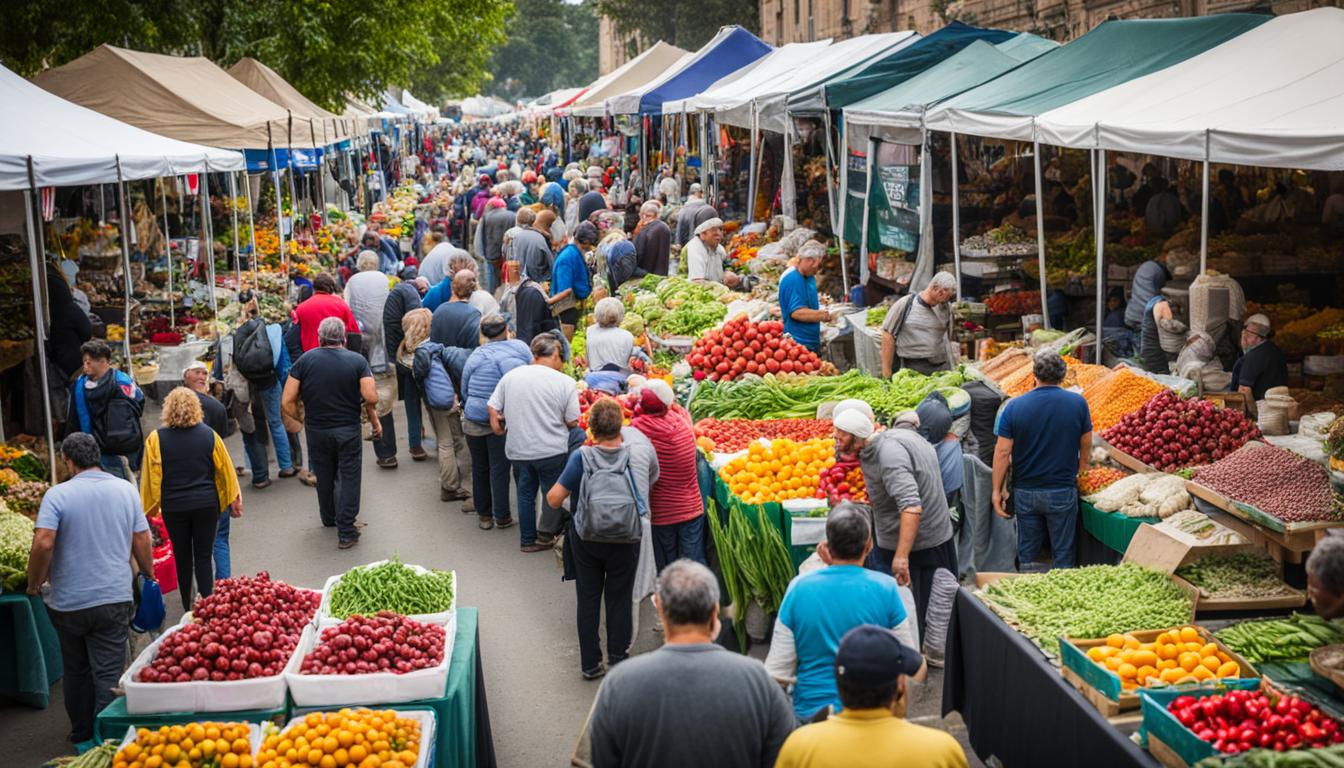
Between 1991 and 2004, sales of organic food jumped from $1 billion to $13.8 billion. This was a big leap and shows how tastes have changed. We’ll see how things like what consumers want, new technology, the economy, and worldwide trends affect farming.
It’s key for anyone in farming to get this. Looking at what’s happening in the market and analysing the farming sector can help predict where things are going. The big growth in organic and natural foods shows why it’s vital to know what consumers like. It’s all about changing business plans to keep up.
New tech is also changing agriculture a lot. Things like smart farming and precise technology are really making a difference. These, along with how the economy is doing and government rules, are shaping farming.
We’ll explore how these different parts come together to affect farming. By understanding all this, people in farming can do better in this fast-changing sector. They can grow their businesses and make more money through smart strategies.
The agricultural sector is ever-changing, influenced by various factors. Those involved must understand market dynamics to succeed. Exploring agricultural trade statistics and market research in farming helps us understand the key elements. These elements affect productivity, prices, trade, and income.
We start by learning about supply and demand, production cycles, and external influences. Oregon’s value-added agriculture and food sectors are a good example. Here, market forces control what things cost and if you can get them. For instance, the organic market affects how organic foods are made and bought, both at home and abroad.
Looking deeply into the markets is essential to get practical insights. We should study various selling methods, like Oregon’s Farmers Markets and Community Supported Agriculture. Also, we should look at big sellers, such as supermarkets and food services. By understanding these sales, stakeholders can make strategies that last. Insights from analyzing trade data can help in making better choices and setting new policies.
The farming scene keeps changing, driven by many new trends and ideas. 2024 looks to be a big year for farming goods, marking chances for big shifts. These changes come from technological advancements, what consumers want, as well as key economic issues.
New tech is quickly changing farming, from clever farming systems to precise planting gear. Farmers today use digital clone technology and smart AI to grow crops more accurately. Eco-friendly packaging, like those made from cornstarch and bamboo, helps lessen our impact on the environment. Smart packages, with added sensors, keep products fresh while they travel, making the agricultural supply chain management smoother.
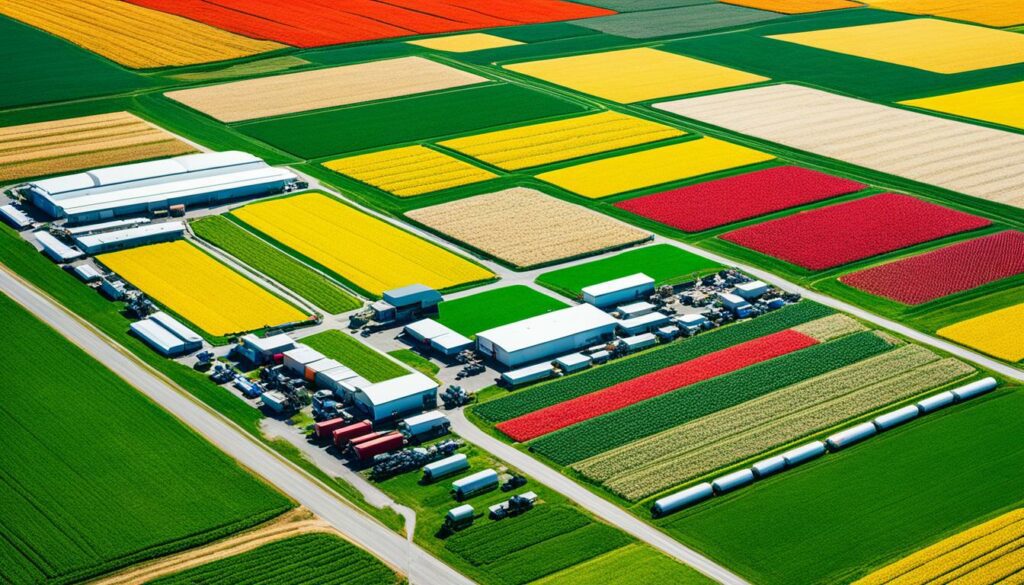
What people want to buy is really changing how farmers grow their crops. More folks are choosing dairy and healthy oils because they care about the planet. The rise of plant-based foods, using things like soy and peas instead of meat, is pushing farmers to change what they grow. Plus, the demand for health foods, including nuts and nut butters, is rising worldwide. All this is affecting how our agricultural supply chain management works.
Money matters a lot in farming and is forcing some big changes. After the pandemic, there’s not enough workers and getting goods from place to place is hard. Prices are going up and down because of world events and issues between the US and China, especially for soy. Plus, what the government decides and the help they give also change how farming is done. Knowing these economic factors in agriculture is key for everyone involved to deal with these hurdles.
Below is a table summarising the main trends and their effects on the market:
| Trend | Description | Impact |
|---|---|---|
| Technological Advancements | Innovations in smart agriculture platforms and sustainable packaging | Enhanced precision in farming and reduced environmental impact |
| Consumer Demand Shifts | Increased demand for plant-based foods and health-conscious products | Alignment of farming practices with consumer preferences |
| Economic Factors | Labour shortages, geopolitical tensions, and government policies | Direct influence on commodity prices, demand, and profitability |
The farming world today mixes many elements like how farms run, making money, and the environment. Looking at the global agriculture market analysis gives us key info about what’s happening now, what might change, and how different places do things.
Current numbers show a smaller U.S. farm count, down by 7% from 2017 to 2023. The land they use also dropped, from 900 million acres to 879 million. But, farms are getting bigger, now covering 464 acres on average, up from 440 acres in the 1970s. These changes point to the big challenges and opportunities in the agricultural sector. They’re about using land better and bringing farms together.
Trends point to a good increase in farm money, with GCFI hitting $549.8 billion in 2024 from $400.3 billion in 2003. But, income might fall by 8.5% in 2023 and 6.1% in 2024. Net farm income, which was at a high in 2022, might drop by 18.9% in 2023 and 27.1% in 2024. These guesses show the challenges and opportunities in the agricultural sector, dealing with up-and-down money and changing markets.
| Year | GCFI (in Billion $) | Net Farm Income (in Billion $) |
|---|---|---|
| 2022 | 600.4 | 196.4 |
| 2023 | 549.8 | 159.2 |
| 2024 | 515.9 | 116.1 |
Place really matters in the global agriculture market analysis. A lot of U.S. farms, 88%, make under $350,000 but big farms make 52% of the money. This shows that where you are and how big your farm is, affects the market. It means we need special plans to help areas and types of farms do well.
Looking at market research in farming uncovers many aspects of global agricultural trade. The U.S. plays a big role in the world market with its farm products. It greatly impacts international trade both through what it sells abroad and what it brings in.

Between 1997 and 2022, U.S. agricultural exports jumped from $62.8 billion to $196 billion. This growth shows the U.S.’s strong influence globally. Products like dairy, meats, fruits, and vegetables are in high demand worldwide. This is partly because more people are looking for better-quality food and their incomes are rising.
In 2021, U.S. farm exports helped create over a million jobs. Each $1 billion in exports supports nearly 7,000 jobs. Since 2013, about 20% of the food and goods produced in the U.S. are sold abroad. This number has stayed pretty stable.
The effects of trade deals are clear when we dive into market research in farming. These agreements are key to adjusting trade and keeping the U.S. competitive. Over the last 25 years, U.S. farm imports have grown a lot, hitting $198 billion by 2022. This shows how important trade deals are, especially for products like fruits and tropical goods, which make up 15% of what the U.S. buys from abroad.
Between 2013 and 2021, the part that products from abroad play increased in the food and drinks the U.S. consumes. This number went up from 13.5% to 17.3%.
Trade pacts trigger changes in markets, affecting how much is exported and the jobs created. The USDA collects and shares vast data to help understand these shifts. By studying this information, those involved in the agricultural market can make better decisions.
Market research is key in farming. It helps all involved understand and deal with the complex web of agricultural supply chains. It also helps in grasping the economic factors in the industry.
Effective research uses both numbers and stories to give clear, useful hints.
Quantitative research lets us measure and crunch numbers. Spreadsheets and stats software make it easier to do this. They help with tracking important farm data, and make guessing market changes more accurate.
On the other hand, qualitative research goes beyond numbers. It pulls useful info from interviews, surveys, or chatting with people both online and offline. Special software helps make sense of all this talking or writing, making the details clearer and reliable.
It’s vital to watch the right things in the farming market. The right data helps people in farming make smart choices when the market changes. Here are some important things to keep an eye on:
| Metric | Description | Use |
|---|---|---|
| Crop Yield | Measurements of crop production per unit area. | Assessing productivity and planning improvements. |
| Market Prices | Current and past prices of farm goods. | Planning for the future and deciding on prices. |
| Input Costs | The money it takes to buy seeds, fertilisers, work, and machines. | Helps in setting budgets and managing costs. |
| Supply Chain Efficiency | Stats on how well things move through the supply chain. | Improving how products get from farms to shops. |
Mixing both numbers and stories helps farmers understand the market better. This, along with watching important stats, helps them deal with the ups and downs of the farm business wisely.
In today’s farming world, making the supply chain more efficient is key. It keeps farms competitive and helps them last longer. This means finding ways to ship and deliver goods better. But, it also means dealing with issues that only farming faces.
Good logistics and delivery are vital to running the agriculture supply chain well. Lots of farm goods spoil quickly, so they have to move fast. The weather also affects how much and the quality of the crops. This makes it hard to match what’s grown with what’s needed.

Using tech like AI and smart data is changing how we move goods in farming. This kind of tech lets us gather and use more data to make better choices. For example, sensors in the fields can watch things like soil moisture and crop health. This can help to use resources better.
There are lots of tough challenges in getting farm goods from fields to stores. Bad weather is hitting crops harder and more often. This makes it harder to predict what we’ll have for sale. Trade issues between countries can also cause big problems.
Problems like diseases can make it hard to find the people and products we need. Farm goods are often different, which makes it hard to set quality rules. Plus, bringing in new workers is tough because farming isn’t a year-round job for many and many workers are getting older.
| Challenge | Impact | Solution |
|---|---|---|
| Extreme Weather Events | Reduction in crop yields | Adopt climate-resilient practices |
| Geopolitical Conflicts | Disruption of goods movement | Diversify sourcing and transport routes |
| Labour Shortages | Reduced productivity | Utilise agricultural robotics and automation |
| Product Variability | Harder quality control | Implement AI-driven standardisation techniques |
Improving the farm supply chain is a never-ending job that needs new tech. Using advanced data and AI can help us deal with these issues. It makes our market work better and last longer.
The global agriculture market is full of economic factors. These affect the industry in many ways, from prices to what policies governments put in place. It’s key to know these to deal with the ups and downs of farming.
Inflation changes how much we pay for farm products. It makes farming costs go up, like for fertilisers and machinery. Farmers can lose money because of this. Also, you might see things costing more when you go to buy them.
The data from the Agricultural Exchange Rate Data Set helps us see these inflation changes since 1970. It’s key for the U.S. farming sector. The International Macroeconomic Data Set also looks at 189 countries. It helps us predict future farming needs.
Governments play a big role in farming with policies on subsidies, tariffs, and trade. The USDA provides predictions on farming for the next 10 years. It helps us understand how policies affect the market.
The Virginia state’s agriculture and forest sectors brought in nearly $106 billion in 2021. They also gave jobs to around 490,295 people. For every job in these fields, another 1.6 jobs come up in the state’s economy. This shows how important these jobs are for the economy.
It’s crucial for those involved in farming to understand inflation and policies. These affect the sector’s future. By knowing about and meeting these challenges, we can help the farming sector grow and last.
The agri sector evolves thanks to new tech. Smart agri platforms and precision farming tech lead the way. They tackle farming’s hurdles, making a sustainable and productive future. Tech changes how markets work, showing us current and future trends.
Smart agri platforms change how farmers work. They use IoT, AI, and machine learning. Managers can now check on crops, soil, and the weather anytime.
Since 2001, more farmers use yield monitors, improving practices. This makes farming more precise.
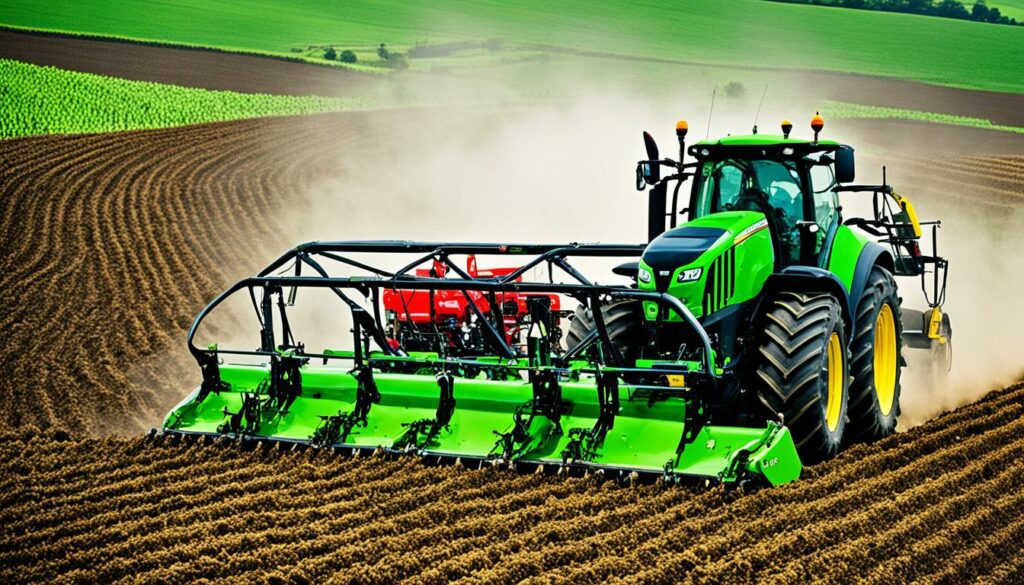
Precision farming boosts output and saves resources. From 2001 to 2016, more farmers used yield maps and varied their fertiliser rates. This helped corn yield rise by 40% since 1996.
It also makes farms run smoother, cuts waste, and helps the earth. As farms grow, these techs are key for managing bigger lands.
These innovations are about more than just now; they plan for tomorrow. They help agriculture stay strong and ready for the future.
Agriculture faces big problems because of climate change. Weather changes affect farming and the economy a lot. It’s expected that by 2050, we’ll have 9.8 billion people globally. This means more pressure on farming. We need quick actions to lessen climate change’s bad effects on our food.
Droughts, heatwaves, and storms hurt crops and how much food we get. Much of the change in how much food we make each year is due to the climate. These bad weather events are thought to get worse, causing trouble in how we buy and sell food and the economy.
The agriculture industry is finding new ways to deal with these problems. They are using stronger crops and better ways to water them. Also, they use smart technology and farming methods that are better for the earth. With these, we might get a bit more food each year. It’s important to use these new ways to make farming safer and more steady.
Using such methods can really help the food market, making it less affected by climate change. Good, solid facts and models that are 95% accurate, like the GTEM-C model, help us plan well against the climate’s shocks. Having good data really matters to fight against the bad effects of climate change.
To end, we must know a lot about how food markets work and be ready to change. We must work together to keep enough food and our economy safe, even with the hard changes in climate.
| Climate Impact | Consequence | Adaptive Measure |
|---|---|---|
| Rising temperatures | Reduced crop yields | Heat-resistant crop varieties |
| Severe droughts | Water scarcity | Efficient irrigation systems |
| Extreme weather events | Production unpredictability | Predictive analytics |
The global agriculture market is booming. It’s growing fast due to higher demand and new technology. This growth is also influenced by changing policies. To really understand it all, looking at each region is key. We also need to make some predictions about what’s coming next.
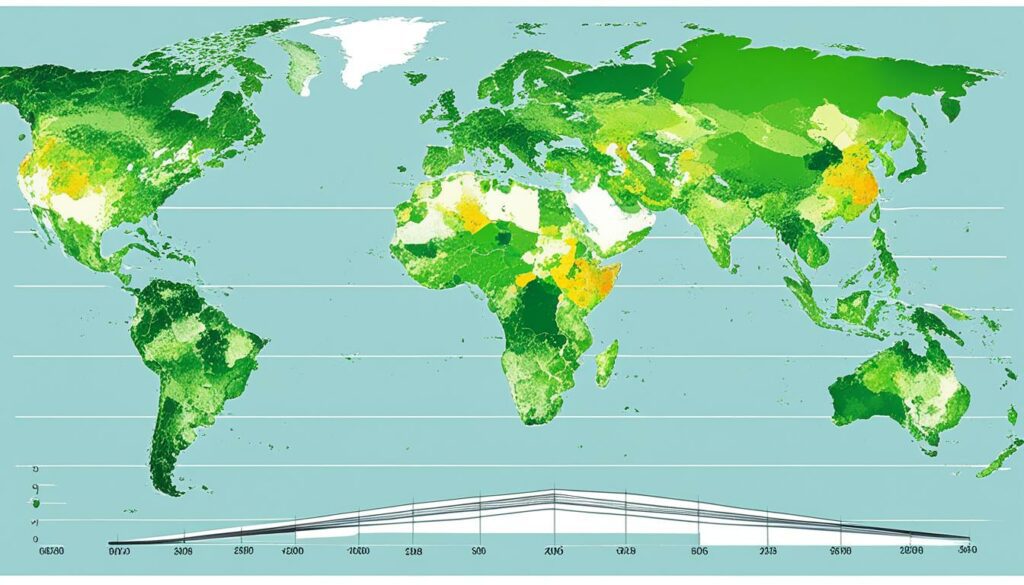
Looking at different regions helps us see the big picture in agriculture. By 2023, the Asia-Pacific area had become the top agricultural market. North America was a close second. Countries like Australia, China, and the USA play a huge role.
COVID-19 hit hard in 2020, affecting many places. It caused problems with getting food and how much we could buy.
By 2027, global grain production is expected to jump by 13%. This is according to the Agricultural Outlook by the OECD and FAO. The whole agriculture market is expected to keep growing, reaching over $19 trillion by 2028.
When we look ahead, we see a lot of changes coming to agriculture. One big change is new technology. The agriculture analytics market was worth more than $5 billion in 2022.
Precision farming and smart platforms are becoming more popular. The precision farming section alone made up nearly half of the market in 2022. But, not all farmers can use these new tools easily. Some have trouble with new technology because they don’t have the right tools. Concerns about keeping data safe are also a challenge. But, there’s a lot of teamwork happening in the market. Partnerships are helping new ideas grow.
The agriculture market will keep growing. New tech and changes in regions will keep pushing it forward.
The agricultural sector is crucial to the global economy. It faces many challenges but also presents various opportunities. With the economy changing and supply chain management evolving, everyone involved must adapt.
Getting into agriculture can be tough. Urban development is taking over farmable land. Only 12% of earth’s land is good for farming. This lack of space limits new farmers’ opportunities to grow.
Then, there’s the issue of water. Farming uses most of the world’s fresh water. But, managing it well is a challenge. Soil erosion adds to this, hurting crops and the land’s future.
Farm Income vs Costs
Farm income is predicted to drop by 20% in 2023. This is mainly because crop prices are falling and it costs more to run a farm. Such tough times can discourage new farmers without enough money to handle these ups and downs.
But, agriculture offers chances for investors too. By using new farming methods, farmers can protect the soil and keep it productive. These methods, like planting cover crops, help reduce soil erosion. They make farming more sustainable and efficient.
Sustainable farming isn’t just good for the planet. It also means better profits for farmers. It’s a win-win that investors are interested in. Plus, with the economy expected to grow and AI set to revolutionise farming, there are plenty of new opportunities to explore.
Better logistics and distribution are key areas for growth. Despite some input costs falling, like fertilisers, others remain stable. Investing in these aspects can lead to big payoffs. For instance, improving how we get things to the farm can save a lot of money.
| Challenges | Opportunities |
|---|---|
| Urban land development reducing arable land | Investment in sustainable farming practices |
| Efficient water resource management | Advancements in AI and automation |
| Soil erosion affecting productivity | Innovations in supply chain management |
| Declining net farm income due to economic factors | Enhanced logistics and distribution networks |
| Rising costs of inputs like labour and interest | GDP growth and technological advancements |
Success in farming often comes from using new ideas and technology. This is clear in different stories showing how companies grow using the latest methods. For example, China’s farming has changed a lot in the last 30 years to be more modern. These changes show how new technology affects markets.
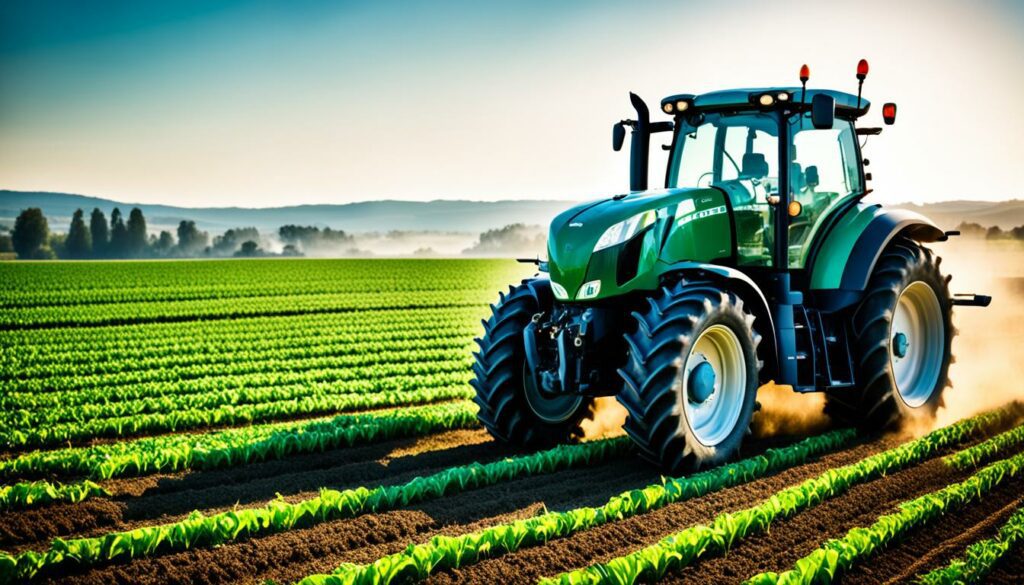
Small farmers in Africa, Asia, and Latin America play a huge role in feeding people, making 80% of the food. In Nigeria, the amount of cereal grown jumped from 7.8 million tons in 1960 to 25 million tons in 2016. This increase shows how new farming methods can boost how much food is available.
Vietnam is facing lower rice production because of rising sea levels. Since 1985, sea levels rising by three millimeters a year are hurting their crops. Vietnamese farmers are using new techniques to fight back. This shows how new tech helps farmers deal with changes and keeps them growing.
The 2018 U.S. Farm Bill is focusing on better research for sustainable food. It’s a vital step because zinc shortage affects two billion people, with half being young children. More research money can develop new tech to solve important health and food problems.
| Region | Key Statistics | Technological Impact |
|---|---|---|
| Nigeria | Increase in cereal production from 7.8 million to 25 million tons (1960-2016) | Enhanced farming techniques boosted productivity |
| Vietnam | Sea levels rising by 3 mm annually since 1985 | Adaptation strategies to counteract climate change effects |
| China | 30 years of agri-food system transformation | Modern production methods revolutionised the sector |
In conclusion, these stories show how vital new technology is in farming. It helps businesses change and grow to meet the market’s needs. By always looking for better ways, these farms can handle worldwide challenges and stay successful.
The market dynamics in agriculture show many factors that affect the global market. Over the years, the way people buy organic foods has changed a lot. This shows us how different parts of the world have their unique ways of doing things.
Looking at trends in different parts of the world helps us understand how agriculture is changing. For example, we are seeing more people wanting to eat organic and natural foods. In Kenya, the amount of maize they grow is a good example of how unique each place is in the agriculture market.
Retail and food service markets play a big role in how products are sold and distributed. The theories about how farming changes are also important. They help us see how technology and new ways of working affect agriculture.
Oregon’s agriculture market is a great example to learn from, showing how businesses work together. Understanding the local food market is key to getting the big picture of agriculture around the world. This deep look at different markets and people’s choices helps us plan better for the future.
The farming sector is changing in our region. This is causing many challenges and chances for growth. Different changes are happening, affecting how things work. One big change is that farming is producing less food in many places. But, there are hopes for better farming practices. This means food production might become more stable in the future.
Different types of farming are happening in various places. Some focus on cereals and pulses, while others grow high-value fruits. There’s also a strong seed industry that can lead to growth. Yet, it’s crucial to understand the social and cultural aspects of farming today. This understanding helps make farming more effective. Farmers face many changing factors, including their traditions and new ideas from various places.
There are various ways of farming, each with its unique methods and goals. These ways are tied to the people, their cultures, and how they work. It’s important to look closely at how farmers interact with their surroundings. For example, how markets and their communities affect their work. Knowing this helps us understand the farming economy better. With a good plan and understanding, we can help agriculture move forward. This includes finding ways to solve problems and make the most of new chances.
Market dynamics in farming change due to consumer needs, tech improvements, economic issues, and worldwide trends. Grasping these points helps us predict the future of markets and find opportunities.
It’s important to look at market dynamics in farming because they affect how much is grown, sold, and the income. This info helps farmers adjust to changes and grow their businesses sustainably.
New farming technologies, like smart platforms and precision tools, bring big changes. They make farms more efficient, productive, and kind to the environment.
Economic elements such as inflation, prices, and government rules shape the farm industry a lot. They can change how much money farms make and can affect the entire market scene.
The farm market is seeing new tech, changes in what consumers want, and shifts in economics. Knowing these trends is key for everyone in farming.
Differences in regions, from the weather to economic plans, greatly affect farming. These factors change how much farmers can grow and what they can grow.
Big exporters and importers like the United States, Brazil, and China influence global farm trade a lot. Trade deals also make a big difference.
Both types of study methods – numbers-focused and insight-focused – work well in farm research. They give us facts and show what people are thinking and buying.
Managing the chain from farm to table can be tough because of weather, keeping things eco-friendly, and needing new tech to work better and safer.
Rising costs and prices can hurt the farm industry by making it more expensive to produce food. This makes it hard to make money.
Policies like subsidies and rules can help or hurt farms. Good policies support green methods and new tech, making things better for everyone.
Innovations include smart farms and precision tech that save resources, boost harvests, and make managing a farm easier.
Climate change brings extreme weather and changes in farming conditions. Farms must adapt to stay strong and productive against these threats.
The future will see more tech, new farming rules, and different consumer choices. These changes will impact farms differently, worldwide.
Getting started in farming is hard because it needs a lot of money, dealing with rules, and facing other farms. But, spotting chances can overcome these difficulties.
Top farms use new methods and tech to do well. Examples include precision farming and eco-friendly ways to farm.